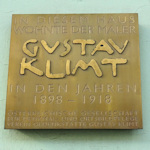
The global names associated with Vienna’s history tend to carry a pen and sheet music. One artist has muscled his way in among the musicians, though: Gustav Klimt.
This Klimt guide covers two sets of locations for those wishing to trace his paint-splattered footsteps:
- Where best to see the paintings and other works
- Landmarks relevant to Klimt’s life, including his final studio, final residence, and final resting place
Klimt was born, lived, worked, and died in the city. So his name and works appear all over the place, often where least expected. All the locations mentioned appear on the map at the end of the article.
- Book a Klimt ticket package* at a discount for 5 museums with his works
- See also:
Klimt: his works
Let us first see what temporary events may be on. And then we can take a gentle journey through the museums and other buildings with permanent displays of Klimt’s oeuvre.
Special exhibitions

(Gustav Klimt, Kirche in Unterach am Attersee, 1916; press photo courtesy of the Heidi Horten Collection)
- Focus on Gustav Klimt: small exhibition at the Heidi Horten Collection around the painting Church in Unterach on Lake Attersee (until June 2nd, 2024)
- Secessions – Klimt, Stuck, Liebermann: the Wien Museum takes a look at the Viennese, Munich and Berlin secessionist movements from the turn of the 19th/20th century (May 23rd to October 13th, 2024)
- Gustav Klimt. Pigment & Pixel: Lower Belvedere takes us behind the canvas to explore the methods, materials and processes behind Klimt’s paintings (February 21st, 2025 to September 7th, 2025)
For more permanent exhibitions and examples, let us begin with the big one…
Belvedere

(Upper Belvedere art gallery and home to The Kiss)
If you’re in Vienna and interested in Klimt, then Upper Belvedere should be your top priority. The permanent art exhibition inside this palace and museum has Klimt’s incomparable masterpiece, The Kiss.
(Visiting Vienna on a Klimt tour and not seeing The Kiss would be like eating a hot dog without the sausage inside.)
Belvedere usually has around a dozen other Klimt paintings on display, too. However, you may not be the only one interested, so book your time slot in advance or risk a wait.
See my article on The Kiss for more advice on how best to see the work.
And look out for any relevant special exhibitions at Belvedere, too. For example, Lower Belvedere had the Klimt. Inspired by van Gogh, Rodin, Matisse… exhibition in early 2023.
Leopold Museum
The Leopold Museum enjoys considerable fame for its Schiele collection, but the Vienna 1900 permanent exhibition includes a whole section dedicated to Klimt.
The Klimt area also has an authentic reproduction of his studio and a small room dedicated to the life and work of Klimt’s long-time friend and muse, Emilie Flöge.
The Albertina
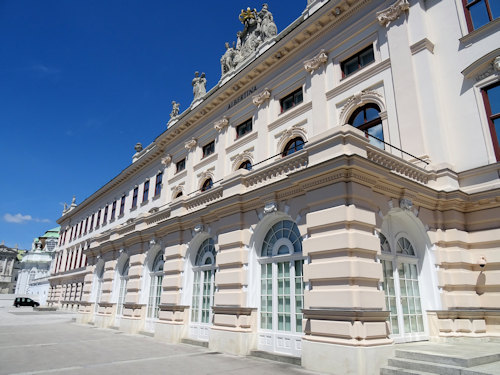
(One side of the Albertina palais and art museum)
The Albertina museum owns more art than you can shake a paintbrush at but most of it lives in storage.
Their Klimt collection covers a vast number of drawings, for example, but what you see really depends on the Albertina’s current special exhibitions: you might be lucky. For example, I once caught Klimt’s 1899 Water Nymphs (Silverfish) work on a visit to their permanent displays.
Wien Museum
(Gustav Klimt’s Pallas Athene, 1898; Wien Museum Inv.-Nr. 100686; reproduced under the terms of the CC BY 4.0 license; photo by Birgit and Peter Kainz)
The Wien Museum main site has the years around 1900 as one of the focal points of its excellent permanent exhibition on the city’s history.
The Fin de Siècle section naturally features art by Klimt and his peers. These works include his seminal 1902 portrait of Emilie Flöge and the square-format Pallas Athena (1898). And they display a replica of the painter’s smock Klimt wore in the latter part of his career.
Kunsthistorisches Museum

(Klimt worked on the decor inside the Kunsthistorisches Museum)
The art history museum is better known for its Titians and Tintorettos. So you might wonder how a major star of Vienna modernism fits into the place. Spoiler: he doesn’t. But…
Franz Matsch, Gustav Klimt and Ernst Klimt were commissioned to contribute to the decorative paintings around the museum’s huge (and majestic) main staircase.
If you’re lucky, a temporary stairs or viewing scope lets you get up close to Klimt’s work.
Burgtheater
The public commission that really established the careers of the Klimts and Matsch was a cycle of ceiling paintings for the Burgtheater.
You don’t have to watch a play to get inside the building and see the frescoes. Simply visit the two main decorative staircases as part of a guided tour.
(P.S. The painting showing a scene from the Globe theatre is the only known Klimt self-portrait.)
Secession building
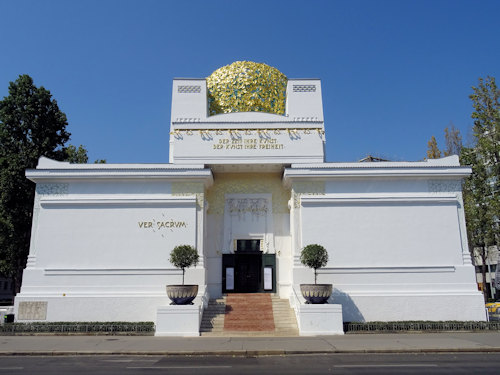
(The trademark golden dome of the Secession building)
The exhibition building of the famous Secession group of artists co-founded by Klimt continues to host contemporary art.
More importantly for our purposes, the gallery’s lower floor provides a home for the huge Beethovenfries wall painting completed by Klimt for the 1902 Beethoven Exhibition.
Hermesvilla
Emperor Franz Joseph built this summer residence in the 1880s for Empress Elisabeth in the Lainzer Tiergarten woodland park. Klimt worked with his brother and Matsch on ceiling paintings you can view in the Empress’s bedroom and salon.
Although in Vienna, reaching the villa takes a while. So don’t make this your priority Klimt stop unless you’re planning on a longer stay.
The MAK museum

(The rather lovely entrance)
Vienna’s MAK museum focuses on the applied arts, but its Vienna 1900 permanent exhibition includes, for example, Klimt’s 1910/1911 series of design drawings for the mosaic frieze found in the dining room of the Josef Hoffmann-designed Stoclet palace in Belgium (now a UNESCO world heritage site).
Theatermuseum
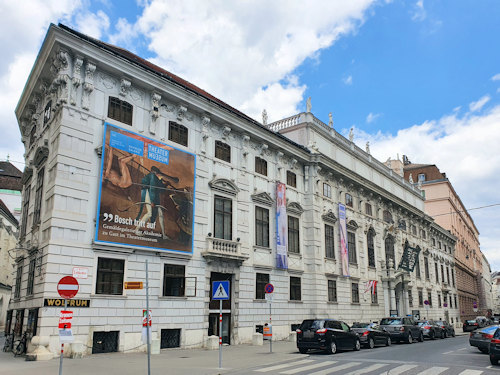
(The museum occupies Palais Lobkowitz, where Beethoven’s 3rd symphony premiered)
And, finally…if it’s not on the road for some exhibition or another, then Klimt’s remarkable 1899 Nuda Veritas (Naked Truth) painting lives in the Theatermuseum in its own small gallery.
Klimt: life and landmarks
Now, let’s take a tour of those locations associated with Klimt’s life and loves…
Birth
Klimt was born at Linzer Strasse 247 on July 14th, 1862 in what is now Vienna’s 14th district. Unfortunately, nothing remains of the original house.
Instead, one of the city’s famous municipal housing blocks now occupies the space. Built in the late 1960s, it recently had an official name change to the Gustav-Klimt-Hof in honour of the artist and location.
The Klimt Villa

(Klimt’s last studio)
The Klimt Villa proved to be the great artist’s final studio, which he used from 1911 to 1918. It’s now open to the public, with an authentic recreation of the furniture and decor as it once was.
The garden even has plants that Klimt might have once tended and whose colours might have provided inspiration for some of his paintings.
Other studios & residences
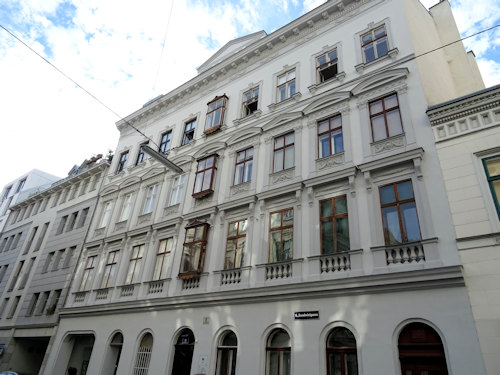
(Sandwirtgasse 8)
You can’t see inside these places (excepting the Otto Wagner Villa), but these are other locations I’ve tracked down:
- Stuckgasse 6: an early studio before the Company of Artists was founded in 1883
- Sandwirtgasse 8: the first joint studio with Ernst Klimt and Franz Matsch
- Josefstädter Straße 21: a joint garden studio with the same, which Klimt continued to use after the Company ended in 1892
- Florianigasse 54: an attic studio Klimt rented for completing the controversial Faculty Paintings that were allegedly destroyed by fire at the end of WWII

(Casa Piccola)
- Burggasse 47: Klimt’s home prior to Westbahnstraße
- Neubaugasse 54: the artist lived here during his childhood
- Casa Piccola, Mariahilfer Straße 1a: location of the Schwestern Flöge fashion salon co-run by Emilie Flöge (Klimt’s “life companion”) from 1904-1938. It occupied the floor above the coffee house. A plaque on an outer wall is dedicated to Flöge and suggests that Klimt and Kolo Moser designed the salon
- Otto Wagner Villa: Klimt was apparently a guest at this gorgeous villa, initially built by the architect Otto Wagner and then renovated and reworked by the artist Ernst Fuchs
Death

(Klimt’s final residence)
Klimt’s final residence was at Westbahnstraße 36 in the 7th district, where he suffered the stroke that was to prove his undoing.
A plaque outside the building commemorates the location and notes (my translation of the German):
The artist Gustav Klimt lived in this house in the years 1898 – 1918

(The old general hospital buildings)
After he fell ill, they took Klimt to the hospital on Alser Straße in the 9th district. He died there on February 6th, 1918. The area now houses a collection of university buildings, bars and shops (and a Christmas market).
Klimt’s grave

(Klimt’s gravestone)
Klimt is buried in the Hietzinger cemetery in Vienna’s 13th district (Maxingstraße 15), adjoining the grounds of the famous Schönbrunn Palace. His well-kept honorary grave carries the number 194/195 in the section marked as Group Five.
(For all the details and directions, see the article on Klimt’s grave.)
And finally…
The souvenir industry has discovered Klimt, so expect to find appropriate mementos all over the city. The Kiss has now transcended the glorious surroundings of Upper Belvedere to appear on a million mugs and mouse pads. Poor Gustav.
